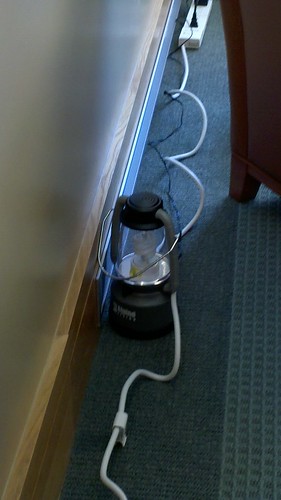 Battery lantern being recharged at Darien Library, originally uploaded by louise.berry.
Battery lantern being recharged at Darien Library, originally uploaded by louise.berry.
What a wonderful thing! During Irene, when many were without power, Darien Library offers outlets and comfort.
Beyond needing a charge during an emergency, it reminded me that sometimes the services a library provides might be a little different than some are used to. I was remind of this piece in LJ:
The Quiet Plug Crisis: http://www.libraryjournal.com/lj/communitybuildingandfacilities/888543-266/the_quiet_plug_crisis.html.csp
At the Mardigian Library at the University of Michigan-Dearborn, the problem had been at the top of students’ wish list for the past several years, according to the Mardigian Library News, and the problem reached critical mass in 2009 as an electrical survey showed that the building was maxing out its power source.
“Amen, brother,” Tim Richards, the library’s director, replied when LJ called and explained it was writing about the problem. “This is a big issue. For a time, it was the biggest complaint I got from students. It wasn’t that they didn’t have access to intellectual content; it was bloody electrical outlets. And for every building built before 1980, no one ever dreamed of this need.”
At Mardigian, 23 additional stations (for $6160) were installed where students could plug in, but the problem still looms. Although Richards is worried since the building is at its capacity, he is cautiously optimistic that the university is going to renovate the library and reconfigure how the power is distributed.
“The astounding thing,” he says, “is every day when I walk into the building at 9 a.m., at least 80 percent of the outlets are already being used.”
And the follow up Letter to the Editor:
No Free Electricity: http://www.libraryjournal.com/lj/community/opinion/889048-274/feedback__letters_to_lj.html.csp
A digital generation scours the library for electrical outlets? You have to be kidding, right (Michael Kelley, “The Quiet Plug Crisis,” LJ 2/1/11, p. 24–25)! Now we are supposed to provide free electricity to anyone who is too cheap to use their own electricity at home? We are supposed to act like a Starbucks or Borders (which, by the way, is going into bankruptcy because its “bookstore model,” which some librarians want to emulate, failed) and provide not only free Wi-Fi but now free electricity?
In Pennsylvania, the state library budget was slashed by 50 percent, our funding from the county was cut by ten percent, and our local funding by five percent. In addition to this, our utility company had its rate caps taken off this year, and we estimate that our electricity bill will increase anywhere from five to 15 percent. Free electricity to all? I don’t think so.
We have an example of this “service” in our library. A user comes into the library with her power strip, plugs it in, and sits for six or seven hours using her laptop. Then she leaves the building. All we are to this person is a free source of electricity and Wi-Fi…. Of course, I can’t blame her. Maybe I should bring in my “digital” devices like my cellphone and GPS and charge them up on the taxpayers’ dime!
This is another example of libraries pandering to the public in exchange for ever-decreasing amounts of revenue. —Harold N. Boyer, Pub. Svcs. Mgr., Springfield Twp. Lib., PA
A difficult issue for sure. As students and public library users continue to utilize various devices, providing access to power seems to me to be a service that aligns the library with its users as a place for access, support and collaboration – during a hurricane or not.
